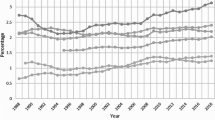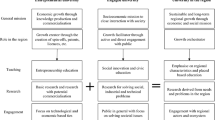Abstract
The emerging field of nanotechnology has created a new frontier for the convergence of university and industrial research. In the United States, major federal investments provided a massive boom for this field over the decade. This paper reports on a case study of how the University at Albany came to establish the first college of nanotechnology in the US, as part of a larger R&D complex oriented towards building a regional nanoelectronics cluster. The case points to the role of entrepreneurs in mobilizing ideas and resources to advance novel organizational forms. This study demonstrates how a mode of technology transfer based on research facilities was deliberately used to build a nanotechnology complex at Albany, highlighting the enabling role of state S&T policies in supporting university engagements in regional economic development.


Similar content being viewed by others
Notes
In another popular definition, Bushan (2006, p. 1) proposes that ‘nanotechnology encompasses the production and application of physical, chemical, and biological systems at scales ranging from individual atoms or molecules to submicron dimensions, as well as the integration of the resulting nanostructures into larger systems’.
In a recent review of papers in higher education journals, Mars and Rios-Aguilar (2010) found that academic entrepreneurs have been more often understood as university professors who engage in commercialization activities, and entrepreneurship tends to refer generally to market-oriented behavior.
Interestingly, the CAT program originated from RPI’s lobbying efforts to secure support from the state for research that would aid the local economy. Political bargaining resulted in the program, which could distribute state resources geographically (Etzkowitz 1997, p. 418). For a detailed account of Low’s efforts, see Leslie (2001).
CESTM was erected with a $10 million state economic development grant, complemented by $2 million from a federal grant and $1.4 million from private sources.
Those include the “Centers of Excellence”, “STAR Centers” (Strategically Targeted Academic Research), and “Gen*NY*sis” (Generating Employment through New York State Science).
In the US context, the term 'pork barrel' refers, in a derogatory manner, to the allocation of government funds to please special interests in the districts of politicians requesting them.
One analysis shows Albany to be the biggest beneficiary of pork-barrel funds in S&T as well as in other areas (Garder and Rosenberg 2006).
They include the International Venture for Nanolithography, the Center for Advanced Interconnect Science and Technology, and the Institute for Nanoelectronics Discovery and Exploration. They involve investments of $500+ million, $500 million, and $435 million, respectively (CNSE Backgrounder 2007, pp. 2–9).
For example, to land SEMATECH and the first Tokyo Electron R&D laboratory outside of Japan, the state footed a $310 million bill.
Quoted from an interviewee on the Albany campus (05/06/2006).
James G. Ryan, a former professor of nanoscience and associate vice president of technology, had worked at IBM for 25 years before joining CNSE in 2005. He left CNSE in 2008 to become the founding dean of the Joint School of Nanoscience and Nanoengineering, affiliated to North Carolina A&T State University and The University of North Carolina at Greensboro. http://cnse.albany.edu/News/index.cfm?step=show_detail&NewsID=1361.
Interview conducted on site (05/06/06).
For example, the National Science Foundation has over the decade supported the prestigious ‘Nano-Scale Science and Engineering Centers,’ awarded through an exhaustive, multi-stage review process. Albany is absent of the list of recipients of those centers, as well as other NSF-supported centers focusing on nano, as well as nanotechnology centers supported by other federal agencies. Several of the NSF Materials Science and Engineering Research Centers focus on nano-scale research; other agencies funding nano-centers include the National Institutes of Health, the Department of Defense, and NASA.
They pledged $1.56 billion to the IBM and AMD plants (Lohr 2006).
Shapira and Youtie (2008, pp. 196–197) do caution, however, that this strategy “has the potential to crowd out other institutional actors who may be helpful in developing and energizing the regional cluster and who may exploit research avenues not favored by the dominant institution.” Their analysis suggests that the most successful ‘nanodistricts’ have multiple centers of R&D and commercialization activities.
In summary, that is because (1) marginal organizations are not beneficiaries of existing ideas and forms that sustain the status quo, and thus have an incentive to pursue alternatives; (2) they are less interconnected with central organizations in the field that sustain the status quo; and (3) they are more exposed to existing contradictions in the field. See Greenwood and Suddaby (2006, 29–30).
References
Abbott, A. (2001). The chaos of disciplines. Chicago: The University of Chicago Press.
Aldrich, H., & Ruef, M. (2006). Organizations evolving (2nd ed.). London: Sage Publications.
Bercovitz, J., & Feldman, M. (2008). Academic entrepreneurs: Organizational change at the individual level. Organization Science, 19(1), 69–89.
Braunerhjelm, P., & Feldman, M. (Eds.). (2006). Cluster genesis: The emergence of technology clusters and their implications for government policies. New York: Oxford University Press.
Bushan, B. (2006). Springer handbook of nanotechnology (2nd ed., p. 1). New York: Springer.
D’Errico, R. A. (2002, July 29). Alain Kaloyeros played big role in Sematech decision. The Business Review (Albany), http://www.bizjournals.com/albany/stories/2002/07/29/story1.html.
DiMaggio, P. (1988). Interest and agency in institutional theory. In L. Zucker (Ed.), Institutional patterns and culture (pp. 3–22). Cambridge, MA: Ballinger Publishing Company.
DiMaggio, P., & Powell, W. (1983). The iron cage revisited: Institutional isomorphism and collective rationality in organizational fields. American Sociological Review, 48, 147–160.
Engardio, P. (2009, January 29). Rebuilding America’s job machine. Business Week, http://www.businessweek.com/magazine/content/09_06/b4118038654198_page_3.htm.
Etzkowitz, H. (1997). From zero sum to value-added strategies: The emergence of knowledge-based industrial policy in the states of the United States. Policy Studies Journal, 25(3), 412–424.
Finn, R. (2002, July 26). Public lives; behind a research center, a geek with great cars. New York Times, 2 B.
Fligstein, N. (1997). Social skill and institutional theory. American Behavioral Scientist, 40, 397–405.
Frickel, S., & Gross, N. (2005). A general theory of scientific/intellectual movements. American Sociological Review, 70(2), 204–232.
Fury, M., & Kaloyeros, A. (1993). Metallization for microelectronics program at the University at Albany: Leveraging a long-term mentor relationship. In Proceedings of the Tenth Biennial University/Government/Industry Microelectronics Symposium. Research Triangle Park, NC, May 18–19, 1993.
Garder, K., & Rosenberg, E. (2006). Capital pork: How state politicians divvy up billions for favored capital projects. Albany, NY: Center for Governmental Research Inc.
Geiger, R., & Sá, C. M. (2008). Tapping the riches of science: Universities and the promise of economic growth. Cambridge, MA: Harvard University Press.
Geiger, R., & Sá, C. M. (2009). Technology transfer offices and the commercialization of university research in the United States. In P. Clancy & D. Dill (Eds.), The research mission of the university: Reforms and response (pp. 177–196). Rotterdam, Boston, Taipei: Sense Publishers.
Greenwood, R., & Hinings, C. R. (1996). Understanding radical organizational change: Bringing together the old and the new institutionalism. Academy of Management Review, 21, 1022–1054.
Greenwood, R., & Suddaby, R. (2006). Institutional entrepreneurship in mature fields: The big five accounting firms. Academy of Management Journal, 49(1), 27–48.
Hardy, C. (1994). Under-organized interorganizational domains: The case of refugee systems. Journal of Applied Behavioral Sciences, 30, 278–296.
Haveman, H. A., & Rao, H. (1997). Structuring a theory of moral sentiments: Institutional and organizational coevolution in the early thrift industry. American Journal of Sociology, 102, 1606–1651.
Hwang, H., & Powell, W. (2005). Institutions and entrepreneurship. In Z. Acs & D. Audretsch (Eds.), Handbook of entrepreneurship research (pp. 179–210). Dordrecht: Kluwer Publishers.
Ingram, P. (1996). Organizational form as a solution to the problem of credible commitment: The evolution of naming strategies among US hotel chains, 1986–1990. Strategic Management Journal, 17, 85–96.
Johnson, A. (2004). The end of pure science: Science policy from Bayh-Dole to the NNI. In D. Baird, A. Nordmann, & J. Schummer (Eds.), Discovering the nanoscale (pp. 217–230). Amsterdam: IOS Press.
Leslie, S. (2001). Regional disadvantage: Replicating Silicon Valley in New York’s capital region. Technology and Culture, 42(2), 236–264.
Lohr, S. (2006, October 28). New York bets on high-tech to aid upstate. New York Times, http://www.nytimes.com/2006/10/28/technology/28chips.html?pagewanted=1&ei=5090&en=bb34fcf6c8299241&ex=1319688000&partner=rssuserland&emc=rss.
Maguire, S., Hardy, C., & Lawrence, T. B. (2004). Institutional entrepreneurship in emerging fields: HIV/AIDS treatment advocacy in Canada. Academy of Management Journal, 47(5), 657–679.
Mangematin, V. (2006). Emergence of science districts and divergent technology: The case of nanotechnologies. Paper presented at the workshop on mapping the emergence of nanotechnologies and understanding the engine of growth and development, Grenoble, France, March 1–3, 2006.
Mangematin, V., & Peerbaye, A. (2003). Life sciences large scale research facilities: What are the effects on technology transfer. Copenhagen: EGOS Conference.
Mars, M., & Rios-Aguilar, C. (2010). Academic entrepreneurship (re)defined: Significance and implications for the scholarship of higher education. Higher Education, 59(4), 441–460.
McCray, P. (2005). Will small be beautiful? Making policies for our nanotech future. History and Technology, 21(2), 177–203.
Mody, C. (2004). Small, but determined: Technological determinism in nanoscience. HYLE—International Journal for Philosophy of Chemistry, 10(2), 101–130.
Mowery, D., Nelson, R., Sampat, B., & Ziedonis, A. (2004). Ivory Tower and industrial innovation: University–industry technology transfer before and after the Bayh-Dole Act. Stanford, CA: Stanford Business Books.
Mowery, D., & Sampat, B. (2006). Universities in national systems of innovation. In J. Fagerberg, et al. (Eds.), The Oxford handbook of innovation. New York: Oxford University Press.
National Science Foundation. (2008). Survey of research and development expenditures at universities and colleges. Arlington, VA: Division of Science Resources Statistics.
Pataki, G. (2004). State of the state address. Albany, NY: New York State Office of the Governor.
Plosila, W. (2004). State science- and technology-based economic development policy: History, trends and developments, and future directions. Economic Development Quarterly, 18(2), 113–126.
Powell, W., & Owen-Smith, J. (2002). The new world of knowledge production in the life sciences. In S. Brint (Ed.), The future of the city of intellect: The changing American University (pp. 107–132). Stanford: Stanford University Press.
Pozen, D. E. (2008). We are all entrepreneurs now. Wake Forest Law Review, 43, 283–340.
Rao, H., & Singh, J. (1999). Types of variation in organizational populations: The speciation of new organizational forms. In J. A. C. Baum & B. McKelvey (Eds.), Variations in organization science. Thousand Oaks: Sage Publications.
Redden, E. (2007, June 5). A raise for the record books. Inside Higher Ed, http://www.insidehighered.com/news/2007/06/05/albany.
Sá, C. M. (2008a). Interdisciplinary strategies’ in U.S. research universities. Higher Education, 55(5), 537–552.
Sá, C. M. (2008b). Strategic faculty hiring in two public research universities: Pursuing interdisciplinary connections. Tertiary Education and Management, 14(4), 285–301.
Saxenian, A. (2006). The new argonauts: Regional advantage in a global economy (p. 42). Cambridge, MA: Harvard University Press.
Saxon, W. (1994, April 27). James Corbett, 65, professor of physics at SUNY in Albany. New York Times, p. 20D.
Schumpeter, J. (1934). Theory of economic development. New York: Oxford University Press.
Shapira, P., & Youtie, J. (2008). Emergence of nanodistricts in the United States: Path dependency or new opportunities? Economic Development Quarterly, 22(3), 187–199.
Small Times University Report and Rankings. (2008, May–June). Small Times.
Small Times University Report and Rankings. (2009). Small Times. http://www.smalltimes.com/whitepapers/wp.cfm?id=1378. Accessed 15 May 2009.
State of New York. (2000, February 15). Governor Pataki, majority leader, speaker: State to provide $15 million for SUNY Albany’s 300 mm wafer pilot manufacturing facility. Press Release.
State of New York. (2001, March 14). Governor Pataki: New York Universities win high-tech research award SUNY Albany and RPI selected for prestigious multimillion dollar research program. Press Release.
Stephan, P., Black, G., & Chang, T. (2007). The small size of the small-scale market: The early-stage labor market for highly skilled nanotechnology workers. Research Policy, 36(6), 887–892.
Strauss, A. (1987). Qualitative analysis for social scientists. Cambridge, UK: Cambridge University Press.
The Project on Emerging Nanotechnologies. (2010). Analysis. Available electronically: http://www.nanotechproject.org/inventories/consumer/analysis_draft/.
Weber, R. (1996). Basic content analysis (6th ed.). Newbury Park, CA: Sage Publications.
Yin, R. (2003). Case study research: Design and methods (3rd ed.). Thousand Oaks, CA: Sage Publications.
Author information
Authors and Affiliations
Corresponding author
Rights and permissions
About this article
Cite this article
Sá, C.M. Redefining university roles in regional economies: a case study of university–industry relations and academic organization in nanotechnology. High Educ 61, 193–208 (2011). https://doi.org/10.1007/s10734-010-9332-8
Published:
Issue Date:
DOI: https://doi.org/10.1007/s10734-010-9332-8




